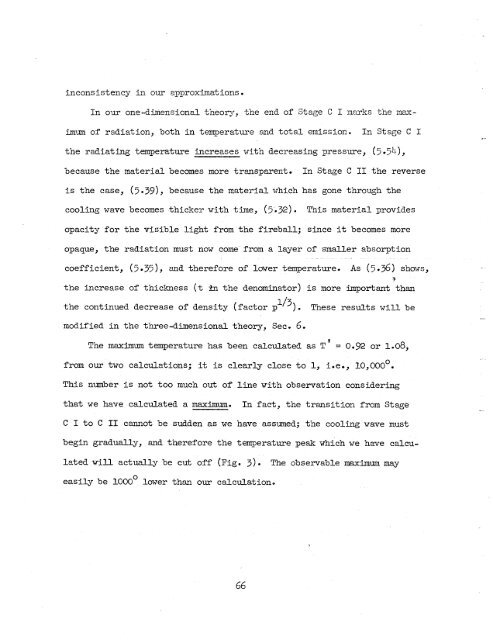Theory of the Fireball
Theory of the Fireball
Theory of the Fireball
You also want an ePaper? Increase the reach of your titles
YUMPU automatically turns print PDFs into web optimized ePapers that Google loves.
inconsistency in our apyroximations .<br />
In our one-diniensional tneoqy, tne end <strong>of</strong> Stage C I narks -<strong>the</strong> max-<br />
Snrrm. <strong>of</strong> radiation, both in temperature and total emission. In Stage C I<br />
because <strong>the</strong> material becomes more transparent. In Stage C I1 <strong>the</strong> reverse<br />
is <strong>the</strong> case, (5.39), because <strong>the</strong> material which has gone through <strong>the</strong><br />
cooling wave becomes thicker with time, (5,.32). Tnis material provides<br />
opacity for <strong>the</strong> visible light from <strong>the</strong> fireball; since it becomes more<br />
opaque, <strong>the</strong> radiation must now come from a layer <strong>of</strong> smaller absorption<br />
coefficient, (5.35), and <strong>the</strong>refore <strong>of</strong> lower temperature. As (5.36) sha~s,<br />
<strong>the</strong> increase <strong>of</strong> thickness (t 2n <strong>the</strong> denominator) is more important than<br />
<strong>the</strong> continued decrease <strong>of</strong> density (factor p 1/3 ). Tnese results will be<br />
modified in <strong>the</strong> three-dimensional <strong>the</strong>ory, Sec. 6.<br />
1<br />
The maximum temperature has been calculated as T = 0.92 or 1.08,<br />
from om two calculations; it is clearly close to 1, i.e., ~O,OOO~.<br />
This number is not too mucn out <strong>of</strong> line with observation considering<br />
tnat we have calculated a maximum. In fact, tne transition from Stage<br />
C I to C I1 cannot be sudden as we have assumed; <strong>the</strong> cooling wave must<br />
begin gradually, and tnerefore <strong>the</strong> temperature peak which we have calcu-<br />
lated will actually be cut <strong>of</strong>f (Fig. 3). The observable maximum may<br />
easily be 1000° lower than our calculation.<br />
66<br />
k
















